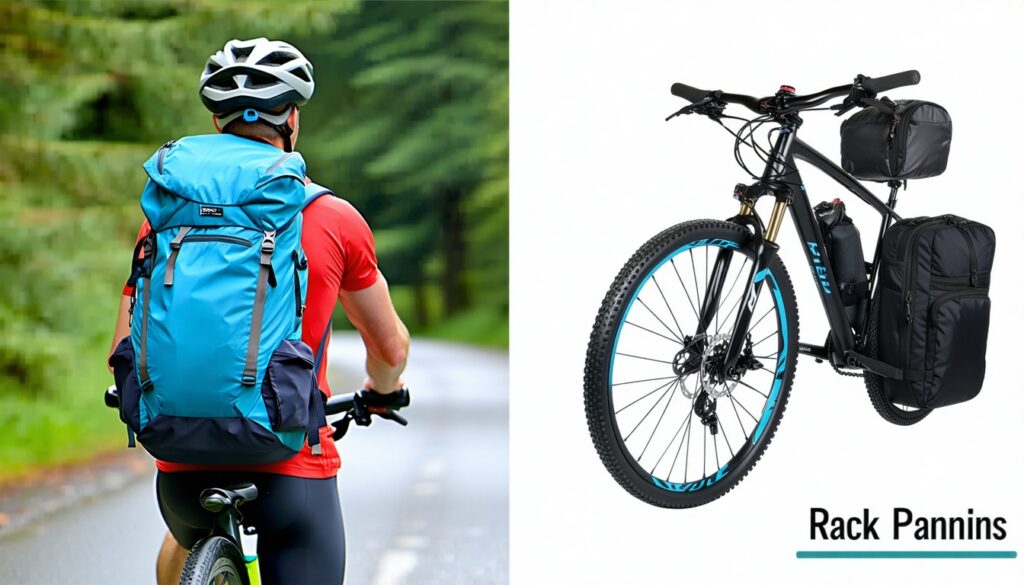Cycling Backpack vs Rack Pannier: Pros & Cons

Weight Distribution Considerations
One of the key aspects to evaluate when choosing between a cycling backpack and a rack pannier is weight distribution. Each option has distinct implications for comfort and stability during rides.
Backpack Discomfort and Fatigue
Using a backpack while cycling often results in the concentration of weight across the shoulders and back. This can lead to discomfort and fatigue, which may degrade the riding experience over time. When a cyclist carries heavy loads, all that weight becomes centralized on the upper body, potentially causing strain and energy depletion (Two Wheel Gear).
| Issue | Effect |
|---|---|
| Concentrated weight | Causes shoulder and back strain |
| Poor posture | Can lead to discomfort during longer rides |
| Heating and sweating | Leads to a less comfortable experience due to moisture buildup |
Pannier Stability and Comfort
In contrast, panniers distribute the weight between a bike’s front and rear wheels. This enhances overall stability and comfort for the rider. The design of panniers allows cyclists to carry a greater load without placing excess stress on their bodies. This method of weight distribution results in improved handling and control over the bike, which is especially beneficial for longer rides or commutes.
| Benefit | Effect |
|---|---|
| Improved weight distribution | Enhances stability and handling |
| Reduced physical strain | Allows for longer rides without discomfort |
| Better energy management | Cyclists can maintain energy levels due to reduced fatigue |
Choosing between a cycling backpack and a rack pannier requires consideration of how weight affects comfort on rides. Panniers generally offer a more comfortable and stable experience, especially for those carrying heavy loads. However, backpacks may provide convenience for lighter loads and quick access to items while cycling, depending on individual needs.
Storage Capacity Comparison
When considering storage capacity in cycling gear, it’s essential to compare the capabilities of backpacks and rack panniers. Each option has its own strengths that can significantly impact a cyclist’s experience.
Backpack Limitations
Backpacks generally offer limited storage space compared to panniers. Most cycling backpacks can hold between 15L to 25L, which may restrict the amount of gear one can carry for longer rides or commutes. This limitation can pose a challenge for cyclists needing to transport larger items, such as a laptop or extra clothing.
| Type of Bag | Capacity Range |
|---|---|
| Typical Backpack | 15L – 25L |
| Larger Cycling Backpack | Up to 30L |
While some backpacks are equipped with features like expandable sections or multiple compartments, they still cannot match the capacity of panniers. For cyclists who require more storage, relying solely on a backpack may lead to uncomfortable packing, leaving essential items behind.
Pannier Versatility
In contrast, panniers provide significantly greater storage capacity. These bags attach to a bike rack and can hold between 20L and 30L each, making them ideal for carrying bulkier items such as work supplies, groceries, and essential gear for longer rides or bikepacking trips. This added space allows cyclists to be better prepared for various situations without feeling weighed down.
| Type of Pannier | Capacity Range |
|---|---|
| Standard Pannier | 20L – 30L |
| Deluxe Pannier Set | 40L+ (for two) |
The versatility of panniers makes them particularly appealing for cyclists who need to transport larger items, ensuring a more organized and balanced load. As riders can utilize multiple panniers, they can distribute weight evenly across their bike, contributing to improved stability while cycling. Panniers can also be customized as part of a bikepacking setup, allowing for various configurations depending on the cyclist’s needs.
Choosing between a cycling backpack and panniers comes down to the rider’s needs. For short trips or simple rides, a backpack may suffice. However, for those requiring ample storage and convenience, panniers are often the superior choice.
Posture and Riding Comfort
Choosing between a cycling backpack and a rack pannier can significantly impact a cyclist’s posture and overall riding comfort. Understanding the differences can help cyclists select the best option for their needs.
Backpack Strain on Muscles
Using a backpack during cycling can lead to discomfort due to the weight being concentrated on the shoulders and back. This can result in a hunched posture, causing strain in the neck, shoulders, and back muscles. As riders attempt to balance the load, they may also experience discomfort and fatigue over longer distances. The risk of developing injuries related to poor posture increases with prolonged use of a backpack while cycling.
| Strain Type | Impact of Using a Backpack |
|---|---|
| Neck Strain | Increased tension and discomfort |
| Shoulder Strain | Possible fatigue and soreness |
| Back Strain | Hunched posture and potential injuries |
For those seeking a comfortable and ergonomic design, it may be beneficial to look into how to choose an ergonomic cycling backpack for comfort and posture.
Pannier Upright Position Benefits
In contrast, using panniers attached to the bike offers a more upright and comfortable posture while riding. The weight is distributed across the bike rather than on the rider’s body, reducing strain on the neck and back. This not only enhances comfort but can also lead to better safety while cycling, as the rider can focus more on the road and less on their discomfort. Additionally, improved posture may reduce the risk of injuries associated with prolonged poor posture.
| Benefit Type | Impact of Using a Pannier |
|---|---|
| Posture | Encourages an upright position |
| Comfort | Reduces strain on neck and back |
| Stability | Improves handling while cycling |
Ultimately, cyclists should weigh the advantages of both options to create the most comfortable riding experience. Those considering interventions to improve comfort may check out features like sternum and waist straps for backpacks, or the convenience of using panniers for everyday commuting.
Accessibility and Convenience
When it comes to accessibility and convenience, both cycling backpacks and rack panniers have their strengths and weaknesses, making them suitable for different riders’ needs.
Backpack vs. Pannier Accessibility
Cycling backpacks typically require the rider to remove the bag to access its contents, which can interrupt momentum during a ride. On the other hand, rack panniers allow for quick and easy access to items without needing to dismount. Panniers often come with multiple compartments and pockets, facilitating efficient organization of essentials such as phones, water bottles, and extra clothing, all while on the move.
| Feature | Backpack Accessibility | Pannier Accessibility |
|---|---|---|
| Need to remove bag | Yes | No |
| Quick access | No | Yes |
| Organizational features | Limited | Multiple compartments available |
Organizational Efficiency on the Go
Panniers generally provide superior organizational efficiency. Their design allows for larger storage spaces, accommodating bulkier items such as laptops, work documents, or groceries. This larger carrying capacity ensures that riders are well-prepared for any situation during their ride without the burden of excessive weight on their back.
In addition, the flexibility of panniers allows them to be easily attached or removed from a bike’s rack. This feature provides riders with the convenience to customize their setup based on the duration or intensity of their ride. For urban cyclists or commuters seeking minimal hassle, this can be a game-changer in maintaining efficiency in everyday cycling.
| Feature | Backpack Organization | Pannier Organization |
|---|---|---|
| Space for bulk items | Limited | Extensive |
| Customizable setup | Not applicable | Easy to attach/detach |
| Effective in urban cycling | Less efficient | Highly efficient |
Both options offer distinct advantages; understanding their differences can help riders choose the right solution for their cycling needs.
Durability and Weather Resistance
When choosing between a cycling backpack and a rack pannier, durability and weather resistance are essential factors to consider. Each option has its own benefits and drawbacks regarding wear and tear, as well as its ability to withstand various weather conditions.
Backpack Wear and Tear
Cycling backpacks come in a variety of materials, which can affect their durability. While many backpacks feature water-resistant fabrics, they may still be prone to wear and tear over time, especially with regular exposure to outdoor elements. For example, straps may fray, zippers can break, and the fabric may deteriorate with prolonged use or exposure to rain. It is essential for cyclists to choose high-quality materials that offer a balance of water resistance and durability. However, water-resistant backpacks may not provide complete protection against heavy rain, potentially leaving belongings vulnerable.
Pannier Material Strength
Panniers generally surpass backpacks in terms of durability and weather resistance. They are often made from robust, weather-resistant materials that ensure belongings stay dry and secure, regardless of the weather conditions. The construction of a pannier typically includes features such as reinforced stitching and waterproof seals, providing better assurance for cycling enthusiasts seeking reliable protection during their rides. Panniers are less likely to suffer damage from exposure to elements, making them a preferred choice for commuters and long-distance cyclists alike.
| Feature | Cycling Backpack | Rack Pannier |
|---|---|---|
| Material Durability | Moderate | High |
| Weather Resistance | Water-resistant | Weather-resistant |
| Wear Over Time | Prone to wear | Minimal wear |
| Protection of Belongings | Moderate | High |
Cyclists should weigh the importance of durability and weather resistance based on their usage patterns and riding conditions. For tailored advice on cycling backpacks, including aspects like ensuring comfort and posture, check out our article on how to choose an ergonomic cycling backpack for comfort and posture.
Commuting Benefits of Panniers
Cyclists who commute regularly often face unique challenges when it comes to carrying their belongings. Panniers have become a popular choice for many, providing several advantages that cater specifically to the needs of daily riders.
Pannier Advantages for Cyclist Commuters
Panniers are designed to offer significant storage capacity, making them an excellent option for cyclists who need to transport various items. Each pannier can typically carry between 20L to 30L, which is sufficient for daily office supplies, clothing, and even lunch. This level of capacity allows cyclists to be well-prepared for any situation without feeling weighed down.
Additionally, panniers attach securely to a bike’s rack, providing stability and eliminating the discomfort associated with carrying weight on the back. This design minimizes strain during rides, making long commutes more enjoyable. Their waterproof designs also ensure that commuters can confidently ride in various weather conditions without worrying about wet gear.
Convenient Features of Panniers
One of the standout features of panniers is their organizational efficiency. They offer quick and easy access to items without requiring the user to remove the bag, unlike traditional backpacks. Most panniers come with multiple compartments and pockets, allowing cyclists to efficiently organize their belongings and reach them while on the go. This makes them particularly valuable for commuters who need to grab items quickly, such as a water bottle or a phone, while riding.
In summary, for anyone considering the dilemma of choosing between a cycling backpack vs a rack pannier, it’s clear that panniers offer enhanced storage, organizational convenience, and comfort tailored for commuting. For more tips on how to choose the right cycling gear, explore articles like How to choose an Ergonomic Cycling Backpack for Comfort and Posture.
Backpack Convenience and Limitations
Cycling backpacks are popular among cyclists for their ease of use and hands-free convenience. However, there are notable limitations that affect comfort and performance, especially when carrying heavy loads.
Backpack Comfort vs. Discomfort
While backpacks provide a convenient solution for transporting gear on a bicycle, using them for extended periods can lead to discomfort. The added weight of the backpack places significant pressure on the shoulders and back, which can cause strain and fatigue over time. Riders may find that this discomfort affects their overall riding experience, potentially leading to energy depletion during long rides. Studies show that carrying heavy loads leads to hunching forward, resulting in neck, shoulder, and back strain.
| Comfort Factors | Backpack | Pannier |
|---|---|---|
| Pressure on Shoulders | High | Low |
| Back Sweat | Common | Less Common |
| Ability to Adjust Load | Limited | High |
Using a backpack can also lead to a sweaty back, making it less ideal for long commutes. Therefore, cyclists may need to consider alternatives to maintain comfort throughout their rides.
Heavy Load Considerations
When cyclists load their backpacks with heavy items, the impact on the body increases. The concentrated weight forces cyclists to shift their posture, often resulting in a hunched position that places undue strain on the upper body. This can be particularly troublesome during longer commutes where sustained comfort is essential. The limitations of backpacks in this regard make them less favorable when compared to options such as panniers, which distribute weight more evenly.
For cyclists planning to carry heavier items, a hydration-compatible cycling backpack might be beneficial, as it allows for both hydration needs and some gear without overwhelming the back. However, it’s essential to be mindful of what is packed and to aim for a balance to avoid discomfort related to heavy loads.
Using a cycling backpack requires careful consideration of both the comfort it offers and its limitations when carrying equipment. For those simply looking to enjoy leisurely rides or commute without the burden of heavy loads, backpacks can be practical. Otherwise, exploring lightweight cycling backpacks for commuting < 20 l might enhance the cycling experience with less strain on the body.
Hybrid Solution: Pannier Backpack Convertible
In the discussion of cycling backpack vs rack pannier: pros & cons, a hybrid solution that has gained popularity is the pannier backpack convertible. This innovative design aims to harmoniously blend the best features of both panniers and traditional backpacks, making it an appealing option for various cycling scenarios.
Benefits of Convertible Pannier Backpack
The Pannier Backpack Convertible, developed by Craft Cadence, offers several advantages. This design features a reliable attachment system that ensures stability while riding, reducing the chances of the bag shifting or becoming unbalanced. The thick padding provides comfort, making it suitable for longer rides. The unique, quick convertible feature allows users to switch easily between backpack and pannier modes, giving cyclists the freedom to choose based on their needs at any given moment.
| Benefit | Description |
|---|---|
| Versatility | Easily switch between backpack and pannier modes |
| Comfort | Thick padding for comfortable wear |
| Stability | Secure attachment system to prevent shifting |
Features of the Pannier Backpack Convertible
Craft Cadence’s Pannier Backpack Convertible incorporates various features designed to enhance the cycling experience. Internal organizational systems include a detachable laptop sleeve organizer, providing protection for electronic devices during trips. Externally, the backpack includes practical options like a water bottle holder and a D-lock holder, making it easier for cyclists to have their essential items readily available while riding.
| Feature | Description |
|---|---|
| Detachable Laptop Sleeve | Organizes and protects laptops during commutes |
| Water Bottle Holder | Keeps hydration accessible while cycling |
| D-Lock Holder | Convenient storage for locking devices |
By considering these benefits and features, cyclists from all walks of life can find an adaptable solution that meets their unique commuting and cycling needs. For further insights on choosing the right cycling gear, explore our guides on how to choose an ergonomic cycling backpack for comfort and posture and hydration-compatible cycling backpacks: what to look for.


